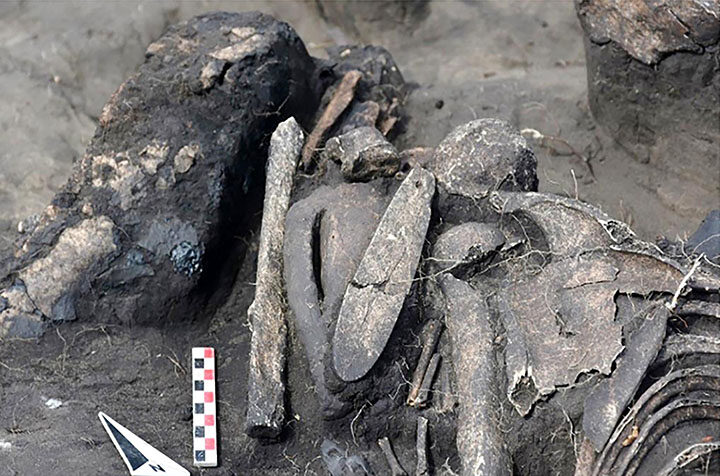The discovery was made this summer inside the mass burial of people from Odinov culture in Vengerovsky district of Novosibirsk region, Western Siberia.
The small - about a palm size - statuette found in situ by the team of Novosibirsk Institute of Archeology and Ethnography had a mask depicting a bear made of a horse vertebrae.

'We've never come across anything like this, despite our extensive knowledge of the Odinov culture's burial rites.
'The woman must have been an unusual person to have such a figurine 'escoring' her to the afterlife', he said.
The woman was laid to rest on top of a man, lying on her front so that she faced him.
The two of them were wrapped in a cocoon of birch bark, which was set on fire before the burial.
The little statuette had a stripe going along its face, which symbolised a tattoo. It was placed on its tummy, and then its head was broken off and turned upside down so that it 'looked up' in a ritual yet unseen by Novosibirsk archeologists.
There was a deepening in the middle of the clay statuette, which had a bronze plate and also some organic substance inside it. Further chemical tests are needed to establish what exactly was placed inside that deepening.
The bone mask made of a horse vertebrae that covered the statuette's head depicted a bear's muzzle, archeologists believe.


'Given that the discovery is 5,000 years old, you can imagine how important it is to understand the beliefs of the ancient people populating Siberia.
'Interestingly, our anthropologists and genetics found that the Odino people were Mongoloids, yet the face of the figurine had clear Caucasian features. We don't see the gender of the figurine, which is unusual, and we can't say if it was dressed', said Vyacheslav Molodin.
The people of Odino culture were cattle breeders, tending to sheep and horses. They were hunters and anglers, too.






Complete confidence in complex tools and methods one doesn't understand will come back to roost. Basically, it is an appeal to authority. I can't see that. If we go on that level of differentiation, I can't even see it is human...